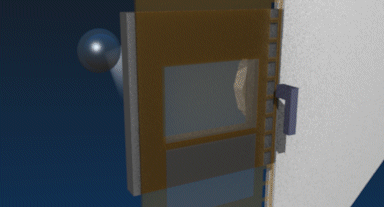A revised and updated version of this article is available.
How many of us see that 1/50 or 1/48 in the bottom of our viewfinders and aren’t really sure what it means? Shutter angles or shutter intervals are part of the cinematographer’s toolkit, but to use them most effectively an understanding of what’s going on under the hood is useful. And that begins with celluloid.

Let’s imagine we’re shooting on film at 24fps, the most common frame rate. Clearly the film can’t move continuously through the gate (the opening behind the lens where the focused light strikes the film) or we would end up with just a long vertical streak. The film must remain stationary long enough to expose an image, before being moved on four perforations (the standard height of a 35mm film frame) so the next frame can be exposed. And crucially light must not hit the film while it is being moved or vertical streaking will occur.
This is where the shutter comes in. The shutter is a portion of a disc that spins in front of the gate. The standard shutter angle is 180°, meaning that the shutter is a semi-circle. A 270° shutter would be a quarter of a circle; we always talk about shutter angles in terms of the portion of the disc which is absent.
The shutter spins continuously at the same speed as the frame rate – so at 24fps the shutter makes 24 revolutions per second. So with a 180° shutter, each 24th of a second is divided into two halves, or 48ths of a second:
- During one 48th of a second, the missing part of the shutter is over the gate, allowing the stationary film to be exposed.
- During the other 48th of a second, the shutter blocks the gate to prevent light hitting the film as it is advanced. The shutter has a mirrored surface so that light from the lens is reflected up the viewfinder, allowing the camera operator to see what they’re shooting.
Frame rate * (360/shutter angle) = shutter interval denominator
24 * (360/180) = 48
So we can see that a film running at 24fps, shot with a 180° shutter, shows us only a 48th of a second’s worth of light on each frame. And this has been the standard frame rate and shutter angle in cinema since the introduction of sound in the late 1920s. The amount of motion blur captured in a 48th of a second is the amount that we as an audience have been trained to expect from motion pictures all our lives.

A greater (larger shutter angle, longer shutter interval) or lesser (smaller shutter angle, shorter shutter interval) amount of motion blur looks unusual to us and thus can be used to creative effect. Saving Private Ryan features perhaps the best-known example of a small shutter angle in its D-day landing sequence, where the lack of motion blur creates a crisp, hyper-real effect that draws you into the horror of the battle. Many action movies since have copied the effect in their fight scenes.
Large shutter angles are less common, but the extra motion blur can imply a drugged, fatigued or dream-like state.
In today’s digital environment, only the top-end cameras like the Arri Alexa have a physical shutter. In other models the effect is replicated electronically (with some nasty side effects like the rolling shutter “jello” effect) but the same principles apply. The camera will allow you to select a shutter interval of your choice, and on some models like the Canon C300 you can adjust the preferences so that it’s displayed in your viewfinder as a shutter angle rather than interval.
I advise always keeping your shutter angle at 180° unless you have a solid creative reason to do otherwise. Don’t shorten your shutter interval to prevent over-exposure on a sunny day; instead use the iris, ISO/gain or better still ND filters to cut out some light. And if you shoot slow motion, maintain that 180° angle for the best-looking motion blur – e.g. at 96fps set your shutter interval to 1/192.